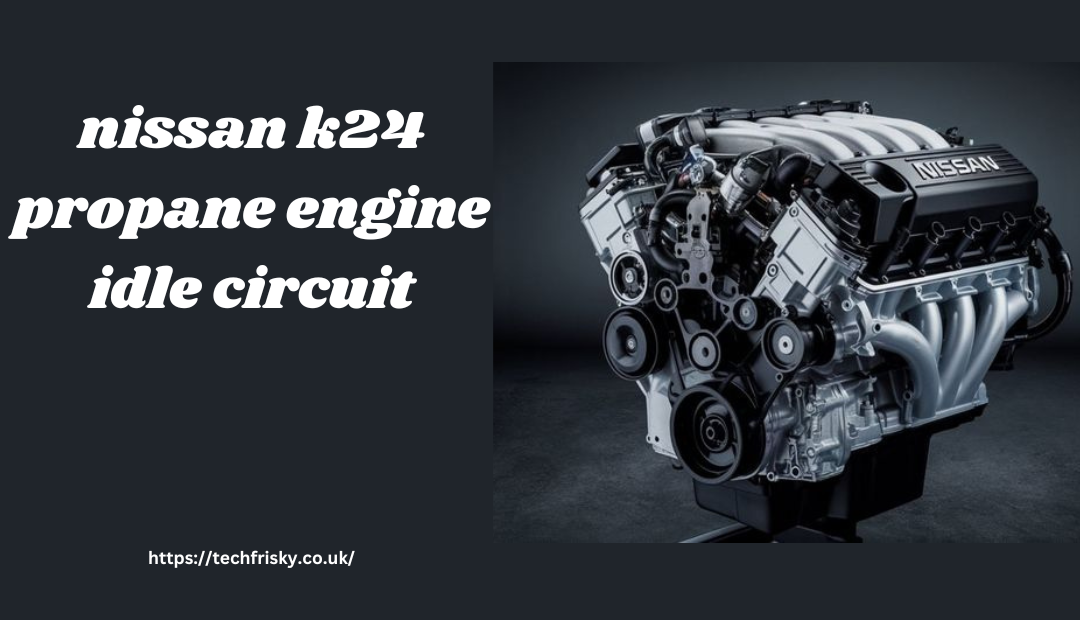The nissan k24 propane engine idle circuit and known for its durability and efficiency, has been adapted for use with propane fuel in certain applications. One crucial aspect of engine operation is the idle circuit, which controls the engine’s behavior when it is running at low speeds or idling. In this article, we’ll dive into how the idle circuit functions in the Nissan K24 propane engine, its key components, common issues, and how to ensure the system runs smoothly.
Overview of the Nissan K24 Propane Engine Idle Circuit
The nissan k24 propane engine idle circuit is a robust 4-cylinder engine that has been widely used in commercial vehicles and industrial equipment. With its transition to propane as a fuel source, the k24 propane idle circuit has become even more versatile, offering cleaner emissions and lower operating costs. Propane engines are especially popular in fleets or off-road environments, where refueling infrastructure is controlled, and the benefits of using propane outweigh traditional gasoline or diesel engines.
Basics of Engine Idle Circuits
An idle circuit is responsible for maintaining engine stability when it is running without load or when the throttle is closed. In simple terms, when you stop accelerating, the engine needs to continue running smoothly at a lower speed. This is managed by the idle circuit, which adjusts airflow and fuel mixture to maintain a steady idle RPM. The proper functioning of the idle circuit is vital for engine reliability, fuel efficiency, and emission control.
The Basic Main Role of Propane in the K24 Engine
Propane, as an alternative fuel source, has unique combustion characteristics compared to gasoline. It burns cleaner and produces fewer carbon deposits, but it also requires specific adaptations to the engine’s fuel delivery system. The K24 propane engine includes modifications that allow it to efficiently burn propane, and the idle circuit is particularly important in this configuration. Proper idle control ensures smooth operation, especially when transitioning between different loads and throttle positions.
Key Components of the K24 Propane Engine Idle Circuit
The idle circuit in the nissan k24 propane engine idle circuit consists of several components that work together to regulate the air-fuel mixture and engine speed when idling. These components include:
- Idle Air Control Valve (IACV)
- Throttle Position Sensor (TPS)
- Engine Control Unit (ECU)
- Airflow sensors (like the MAF or MAP sensors) Each of these plays a critical role in ensuring that the engine maintains a steady idle, regardless of environmental factors or varying fuel conditions.
Key Components of Idle Air Control Valve (IACV)
The Idle Air Control Valve (IACV) is one of the key components of the idle circuit. This valve regulates the amount of air that bypasses the throttle when the engine is idling. It adjusts in real-time to maintain the engine’s idle speed, compensating for changes in load or air temperature. In a propane-powered k24 propane idle circuit, the IACV is especially important because propane has different air-fuel ratio requirements compared to gasoline. Any malfunction in the IACV can lead to rough idling or stalling issues.
The Role of the Throttle Position Sensor (TPS)
When the throttle is closed, the TPS ensures that the engine enters idle mode and that the IACV and other systems adjust accordingly. In a propane engine, accurate TPS readings are essential to prevent incorrect air-fuel mixtures, which could affect idle stability.

How the Engine Control Unit (ECU) Manages Idle
The Engine Control Unit (ECU) is the brain behind the operation of the idle circuit. It processes data from various sensors, including the TPS and IACV, to determine the best air-fuel ratio and adjust engine speed accordingly. In a propane engine, the ECU must consider the unique properties of propane, ensuring that the mixture is lean enough for clean combustion but rich enough to maintain a steady idle. A malfunctioning ECU can lead to idle surging, stalling, or rough performance.
Common Idle Issues in the Nissan K24 Propane Engine Idle Circuit
Like any engine, the nissan k24 propane engine idle circuit can experience idle problems over time. Common issues include:
- Rough idle: The engine feels shaky or unsteady when idling.
- Idle surging: The engine’s RPM fluctuates without input from the driver.
- Stalling: The engine cuts off when idling, often when coming to a stop. These issues can be caused by faulty sensors, a clogged IACV, or problems with the propane fuel delivery system.
Symptoms of Idle Circuit Malfunctions
Recognizing the signs of a malfunctioning idle circuit is essential for maintaining engine performance. Symptoms to watch for include:
- Erratic RPMs when the engine is idling.
- Hard starting after the engine has been idle for an extended period.
- Frequent stalling when the vehicle is at a standstill.
- Engine misfires at low speeds.
Troubleshooting Idle Problems
If your Nissan K24 propane engine is experiencing idle problems, troubleshooting typically involves:
- Checking the Idle Air Control Valve for blockages or malfunctions.
- Testing the Throttle Position Sensor to ensure it’s providing accurate readings.
- Scanning the ECU for error codes that might indicate sensor or system failures.
- Inspecting for any leaks in the propane fuel system that could affect engine performance. A systematic approach to diagnosing these issues can help pinpoint the root cause quickly.
Adjusting the Idle Speed on a Nissan K24 Propane Engine Idle Circuit
In some cases, adjusting the idle speed may resolve minor idle issues. On the nissan k24 propane engine idle circuit and this typically involves recalibrating the IACV through the ECU or using manual adjustment screws (if available). It’s important to follow manufacturer recommendations when making these adjustments to avoid setting the idle too high or too low, which could lead to further engine problems.
Importance of Routine Maintenance for Idle Performance
Routine maintenance is key to ensuring that the idle circuit in the nissan k24 propane engine idle circuit continues to function properly. This includes:
- Regularly cleaning the IACV to prevent buildup.
- Ensuring that the TPS is calibrated correctly.
- Checking for any propane leaks in the fuel system. By maintaining these components, you can avoid many of the common idle problems that arise over time.
Comparison of Propane vs Gasoline Engine Idle Circuits
While the general function of an idle circuit is similar between propane and gasoline engines, the air-fuel ratio for propane engines is different due to the properties of propane. Propane requires a leaner mixture to burn efficiently, and this affects how the idle circuit is configured. As a result, the ECU programming and sensor calibrations are often different for propane engines like the Nissan K24.
Upgrading the Idle System for Better Performance
For those looking to optimize their K24 propane engine, upgrading the idle circuit components can provide more stable performance. High-quality aftermarket IACVs or more advanced ECUs with programmable settings can help fine-tune the idle circuit for specific operating conditions, improving both fuel efficiency and reliability.
Conclusion Results of Nissan K24 Propane Engine Idle Circuit
The idle circuit in the nissan k24 propane engine idle circuit plays a critical role in maintaining smooth engine operation when idling. By understanding how components like the Idle Air Control Valve (IACV), Throttle Position Sensor (TPS), and Engine Control Unit (ECU) work together, and keeping these systems well-maintained, you can ensure that your engine continues to perform efficiently. Proper attention to idle system performance will lead to better fuel efficiency, smoother driving, and a longer engine life
